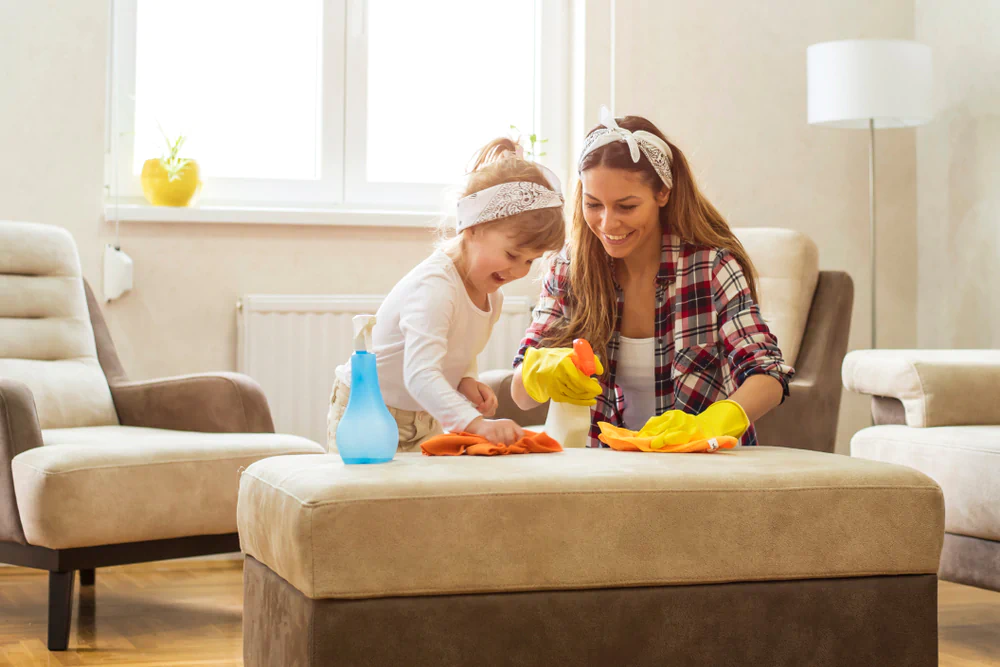Mess and accidents can happen at any time, especially to our perfectly pristine white couches or velvet armchairs. When a glass of red wine spills or a marker tip glides across the surface of our furniture, the immediate panic sets in.
It’s ruined! I’ll never get that stain out! I spent so much money on this sectional!
Before you begin looking for a new sofa as your leading solution, there are ways to clean your upholstered furniture — the right way.
Choosing the right furniture cleaner can feel overwhelming with so many products and methods available. Whether you're dealing with everyday dust or tackling stubborn stains, understanding what works (and what doesn't) can save you time, money, and potentially your favorite piece of furniture.
As furniture experts who've seen every cleaning mishap imaginable, we're here to set the record straight on effective cleaning methods that actually work.
- Always check your furniture’s cleaning code (W, S, WS, or X).
- Use a pH-neutral furniture cleaner designed for upholstery.
- Blot, don’t rub — rubbing pushes stains deeper.
- Avoid excess water; it can cause water rings or mold.
- Test any cleaner in a hidden spot first.
- Choose performance fabrics like Crypton for easy maintenance.
What is the best way to clean a fabric couch?
The best approach to cleaning your upholstered couch depends on the type of fabric and the severity of the mess. There are different methods you can use for regular cleanings (where there may not be an immediate mess to clean up) and deep cleanings to get your desired results.
For weekly maintenance cleaning:
- Vacuum thoroughly using upholstery attachments to remove surface dirt and debris
- Pay special attention to crevices where crumbs and pet hair accumulate
- Rotate and fluff cushions to prevent permanent impressions
- Follow proper cushion and fabric care techniques to maintain furniture shape and appearance (we have an entire guide on just this)
With the holidays just around the corner, we highly recommend getting a head start on cleaning your furniture and making it a weekly habit. That way, you’re not spending ages pulling clumps of pet hair out of the vacuum because you haven’t cleaned your couch in ages.
For deep cleaning:
For those really saturated stains or dirty, dirty sofas, professional-grade steam cleaning (also called hot water extraction) consistently delivers the best results. This method uses heated water and powerful suction to remove embedded dirt, allergens, and other contaminants that regular vacuuming can’t reach.
If you're handling the deep cleaning yourself:
Use a pH-neutral upholstery cleaner specifically designed for your furniture’s fabric type. Always test any furniture cleaner in a discreet area first to see how the fabric reacts — this simple step can prevent costly damage to visible areas.
What do professional sofa cleaners use?
Professional cleaners rely on commercial-grade equipment and specialized cleaning solutions that aren't typically available to regular consumers. Here's what the pros use:
Equipment:
- Truck-mounted or portable extraction units with heated water capabilities
- Professional-grade vacuum systems with HEPA filtration
- Steam cleaning machines are designed specifically for upholstery
- Specialized brushes and agitation tools for different fabric types
Cleaning solutions:
What is the best thing to use to clean furniture? Professional furniture cleaners use commercial-grade, pH-balanced solutions formulated for specific fabric types that clean effectively without leaving harmful residues or causing degradation. These cleaners are more concentrated and effective than consumer products, but they also require proper training to use safely.
Techniques:
Professionals understand fabric construction and use appropriate cleaning methods for each material. They know when to use dry cleaning methods versus wet cleaning, how much moisture different fabrics can handle, and how to prevent over-wetting that can lead to mold or your cushions shrinking.
How to clean extremely dirty upholstery without damaging it
So what happens when your sofa, sectional, chair, or chaise is incredibly soiled? Cleaning filthy upholstery requires a systematic approach — and a lot of patience, as rushing the process often makes things worse. Here are some steps you can take when dealing with dirty furniture:
Step 1: Assessment
First, identify what you're dealing with. Dirt, food stains, pet accidents, and general grime all require different approaches. Check your furniture's cleaning code to see what method works best for that particular piece (usually found on a tag):
- W: Water-based cleaners only
- S: Solvent-based cleaners only
- WS: Either water or solvent-based cleaners
- X: Professional cleaning only
Step 2: Pre-treatment
For heavily soiled areas, pre-treatment is crucial. Use a gentle furniture cleaner appropriate for your fabric type and follow the manufacturer's instructions. Some might say to leave it on for 5–20 minutes, depending on the situation. This breaks down embedded soil before the main cleaning process.
Step 3: Deep cleaning
In our opinion, professional extraction cleaning works best for extremely dirty upholstery. The combination of heated cleaning solution, agitation, and powerful suction removes more soil than any surface cleaning method. When in doubt, you can always speak to a professional cleaner to get their opinion on the best cleaning method.
What doesn't work:
- Using too much water ( which can cause water stains or mold)
- Scrubbing with harsh brushes (this damages the fabric fibers)
- Using household cleaners not designed for upholstery
- Attempting to clean silk or antique fabrics without professional help
How to remove stains from furniture
Stain removal success depends entirely on acting quickly and using the proper techniques. Here's what actually works for removing stains from your furniture.
Immediate response:
- Blot (never rub) liquid spills immediately with a clean, dry cloth or paper towel
- Work from outside the stain toward the center to prevent spreading
- Remove solid spills with a spoon or dull knife before cleaning
Effective stain removal methods:
Different stains require different approaches:
- Food and beverage stains: Use a mixture of mild dish soap and water, applied with a clean cloth. Blot, don't scrub.
- Grease stains: Sprinkle cornstarch or baking soda immediately to absorb oil, then vacuum after 15 minutes. Follow with a solvent-based furniture cleaner if safe for your fabric.
- Pet accidents: Enzymatic cleaners specifically designed for pet stains work best because they break down the proteins that cause odors.
What doesn't work for stain removal:
- Using bleach on colored fabrics (causes permanent discoloration)
- Rubbing or scrubbing (pushes stains deeper into fibers)
- Using too much water (can cause water rings or fabric damage)
- DIY solutions like vinegar on certain fabrics (can set stains permanently)
When DIY furniture cleaning fails
Sometimes, despite your best efforts, DIY cleaning isn't enough. Here are signs it's time to call professionals:
- Stains return after cleaning (indicates the stain wasn't fully removed)
- Fabric appears discolored or damaged after cleaning attempts
- Persistent odors remain despite thorough cleaning
- You're dealing with antique or delicate fabrics
- The furniture hasn't been professionally cleaned in over a year
Professional cleaning becomes especially important for maintaining your upholstered furniture because proper maintenance extends the furniture’s lifespan. Understanding the dangers of used furniture also highlights why maintaining your current pieces is often more cost-effective than replacing them with pre-owned alternatives that may harbor hidden stains, odors, or structural issues.
Understanding your fabric type matters
Not all fabrics respond the same way to cleaning methods. Understanding what you're working with is crucial for choosing the right furniture cleaner.
- Performance fabrics: These innovative materials are designed to repel liquids and resist stains, making them incredibly easy to clean. Most spills can be blotted away with just water, and they rarely require professional cleaning. The benefits of Crypton fabric and similar performance materials include superior stain resistance, liquid repellency, and simplified maintenance routines.
- Natural fibers: Cotton, linen, and wool require gentler cleaning methods and may benefit from professional cleaning to maintain their appearance and texture.
- Synthetic blends: Most modern furniture features durable polyester blends that respond well to standard cleaning methods and resist most stains.
Expert tip: We highly recommend performance fabrics for all living room furniture. Fabrics like Crypton represent the most durable fabric for a sofa in terms of indestructibility and maintenance ease. If you want to protect your furniture from spills, stains, pet dander, and dirt, you will not regret choosing performance upholstery for your furniture.
Common furniture cleaning mistakes to avoid
If you’re uninformed on how to properly clean your upholstered furniture, you could end up damaging your pieces. Doing a quick Google search may not give you all of the information you need to make informed decisions. As a quick guide, avoid these common mistakes to prevent furniture damage:
- Using too much cleaning product: More isn't better when it comes to furniture cleaners. Using excess product can leave residue on the fabric that attracts more dirt or leaves a stain of its own.
- Rushing the drying process: Allowing your furniture to fully dry prevents mold and mildew. You can use fans to improve air circulation, but avoid using direct heat on your furniture.
- Ignoring manufacturer care instructions: These guidelines exist for a reason. Following them prevents warranty issues and maintains fabric integrity.
- Using the wrong tools: Harsh brushes can damage delicate fibers permanently, and reupholstering pieces is an expensive, poor choice.
How to protect your furniture
The best way to ensure that your furniture stays clean and pristine is prevention. Here are proven methods to protect upholstered furniture and help it last longer:
- Establish cleaning routines: Regular vacuuming and addressing spills when they happen can prevent small problems from becoming major cleaning challenges.
- Choose appropriate fabrics: When selecting new furniture, consider your lifestyle. Families with children and pets benefit enormously from performance fabrics that require minimal maintenance and are resistant to spills and stains.
- Proper placement: Keep furniture away from direct sunlight and heat sources to prevent fading and fabric deterioration.
- Use furniture protectors: For times where the possibility of messes is heightened, quality fabric protection creates an invisible barrier against spills and stains, making future cleaning much easier.
Effective furniture cleaning isn't about having the most expensive furniture cleaner or the latest gadgets — it's about understanding your fabric type, using appropriate methods, and acting quickly when problems arise. Regular maintenance, immediate spill response, and periodic professional cleaning will keep your furniture looking beautiful for years.
The key to successful furniture care is consistency, appropriate products, and knowing when to call professionals. With the right approach, even the most heavily used furniture can maintain its beauty and comfort for decades.
Get expert furniture styling and maintenance advice at Living Designs Furniture
When you invest in quality furniture, proper care and cleaning help extend the value of that investment. Whether you're maintaining current pieces or selecting new furniture, understanding effective cleaning methods like choosing the right furniture cleaner helps you make informed decisions that support your lifestyle and budget.
Here at Living Designs Furniture, our experts are here to help you with any questions or queries you may have. Furnishing a new home? We’d love to help! Redecorating your living room? See what we have in store for you. Looking to upgrade your furniture? We make Houston’s best furniture for the best prices.
We are a local furniture manufacturer that creates quality furniture Houston families trust to fill their homes with, right here in our Downtown Houston factory. Visit any of our Houston furniture stores today to get your design journey started. Whatever you’re looking for, we have what you need.
More Helpful Articles by Living Designs Furniture:
- What is Crypton Fabric?
- What is the Best Fabric for a Sofa?
- 4 Reasons to Buy a Performance Fabric Sectional
- Everything You Need to Know About Performance Fabric
- Experts Answer: Where to Buy Living Room Furniture






